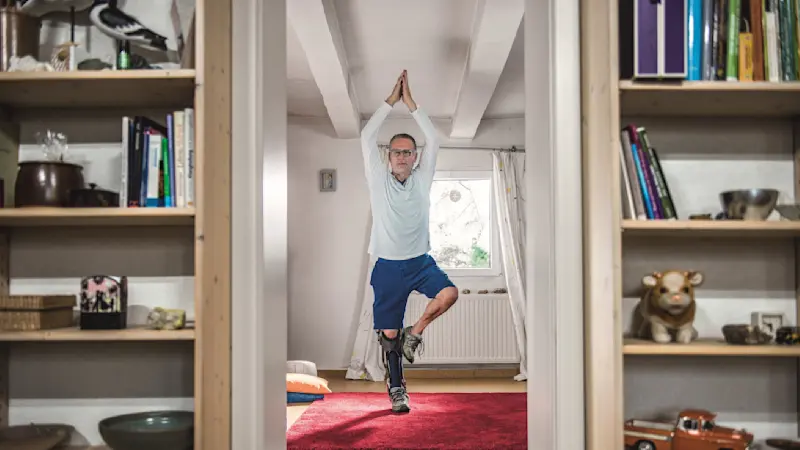Study confirms: 80 per cent fewer falls with the C-Brace
The world's first computer-controlled leg orthosis sets new standards in neuro-orthotics

Thursday, 2 November 2023
Study objective:To provide clinical evidence of the effectiveness of the C-Brace compared with conventional leg orthoses on 102 patients with neurological and muscular paralysis of the legs.
Significant results: The systematic comparison verifies 80 per cent fewer falls with the C-Brace compared with conventional orthoses. Mobility and quality of life improve significantly.
Technical innovation: Thanks to microprocessor technology, the C-Brace makes a major and clinically significant contribution to improving balance and reducing falls.
Improved quality of life: “When I was first fitted with the C-Brace, after so long I finally had the feeling of being safe again,” says a patient with post-polio syndrome.
Reduced risk of falling, more mobility and better balance: The computer-controlled C-Brace leg orthosis facilitates everyday movement patterns such as sitting down, walking and climbing stairs better than conventional leg orthoses. This has been proven for the first time by an international study published in September 2023. This means a significant improvement in quality of life and freedom of movement for people who have limited mobility and an increased risk of stumbling and falling due to paralysis caused byneurological or muscular impairments.1
The randomised, controlled cross-over study focused on comparing the C-Brace with conventional leg orthoses called KAFOs (Knee-Ankle-Foot Orthoses) and SCOs (Stance Control Orthoses). As the world’s first and only SSCO (Stance and Swing phase Control Orthosis), the C-Brace regulates both the stance and swing phase when walking, resulting in a more dynamic and sensitive gait.While KAFOs and SCOs only lock or open the knee joint, thus having limited function, sensor technology supports the entire gait cycle.
The primary objective of the study was to assess balance for each orthosis using the Berg Balance Scale (BBS).2 The secondary criteria focused on actual falls, mobility, function and quality of life. Professor Dr Frank Braatz, a professor of orthobionics and a specialist in orthopaedics and accident surgery, physical and rehabilitative medicine in the Centre for Healthcare Technology at Göttingen Private University of Applied Sciences, led this international clinical study. 102 patients from 13 study centres in Germany, Austria, the Netherlands and the USA took part.
“It’s about regaining independence, about participating in life to the maximum extent. For people with neurological disorders who have muscular deficits in controlling the knee joint, for example after incomplete paraplegia or poliomyelitis, this means a higher quality of life. The tests showed significant improvement on the Berg Balance Scale using the C-Brace. These are benefits and functions that other orthoses are simply unable to achieve to this extent and which also enhance patient safety,” said Professor Braatz, describing the results.
Life-changing effects thanks to microprocessors
The study shows that the world’s first and currently only stance and swing phase control orthosis (SSCO) provides a number of significant advantages over conventional KAFOs – which remain the standard orthopaedic device treatment for individuals with lower limb muscle paralysis.With standard orthoses, the gait often remains faltering and unsafe, especially on uneven terrain. The limitations of these KAFOs also become apparent when taking steps of different lengths, changing directions or ascending stairs and inclines.
The C-Brace overcomes these disadvantages with its smart technology: Its integrated sensors detect knee flexion and knee angular acceleration, allowing it to control both the swing and stance phase of the gait cycle in real time via a microprocessor. It detects which movement is being performed and how quickly – 100 times per second. The data are sent to the microprocessor, which controls knee flexion and extension using hydraulics and simultaneously controls the required leg support.
In this way, the computer-controlled orthosis dynamically supports the entire gait cycle, on all types of terrain. Everyday movements become possible again, including standing, sitting down while carrying a load, climbing stairs and walking at varying speeds. Thanks to a smooth gait without locked orthotic joints and the stumble recovery function, fewer compensating movements are required, leading to improved body posture and reduced physical strain. Long-term secondary damage caused by such compensating movements is therefore reduced or entirely avoided.
Comparison of studies based on real-life experiences
During the study, people with lower limb paralysis and increased risk of falls were randomised into two groups. They each used the C-Brace with the SSCO sensor technology and their KAFO or SCO for three months. This allowed them to gain real-life experience with the various orthoses in their everyday world. The primary objective was to check the Berg Balance Scale after the test phases. To what extent has the patient’s balance changed with each orthosis, as an indicator of a reduced risk of falling?
This comparison shows that the stance and swing phase control C-Brace orthosis significantly improves static and dynamic balance, in contrast to the KAFO or SCO, which merely lock or open the knee joint. As a result, the number of falls was drastically reduced by 80 per cent. In this context, it was also found that study participants using the C-Brace had a reduced fear of falling indoors or outdoors and enhanced mobility – with an associated improvement in their quality of life.
”With the new results, we are achieving a quality of study that is unprecedented in the neuro-orthotics field. They confirm that the functions of the C-Brace are unique in the world and play a significant role in helping patients manage the challenges of daily life. This will enable us to provide decision-makers such as doctors and funding bodies with a solid basis from which to prescribe and approve C-Brace systems,” says Alexander Hardt, NeuroMobility Marketing Manager at Ottobock Germany.
Polio patient Wolfgang: “Finally feeling safe again”
Wolfgang Kierdorf (72) from Saarland has been using the C-Brace for some time and has had positive experiences with the device. His legs have been paralysed since he was eight years old due to polio. Wolfgang had been reliant on devices long-term since childhood, but even these had their limits, as the passionate rider recalls. “I’ve walked around with a locked orthosis my whole life and always had a disability.” He also developed post-polio syndrome at the age of 40. This period was dominated by the fear of falling. Wolfgang suffered severe bone fractures on several occasions and had numerous stays in hospital.
“When I was fitted with the first generation of the C-Brace, I felt safe again for the first time in a long time,” Wolfgang says. “It’s probably hard to imagine how precious that is. That’s incredible progress.” The ability to walk smoothly, stepping down gently with an unlocked knee joint and support even when there are tripping hazards – this leg orthosis sets new standards in neuro-orthotics.
The study data offer great potential for significantly advancing patient selection and treatment. So that people like Wolfgang can go through life safely and without fear.
Further information:
Gait cycle: C-Brace® compared to no treatment | Ottobock – YouTube
Gait cycle: C-Brace® compared to a locked KAFO | Ottobock – YouTube
[1] According to the United States Paralysis Prevalence and Health Disparities Survey, 1.7 % of the population in industrialised countries are affected by paralysis of the limbs and rely on orthoses for daily life.
[2] The BBS is a common, performance-based tool used for evaluating balance with an orthosis based on 14 parameters and making it comparable

